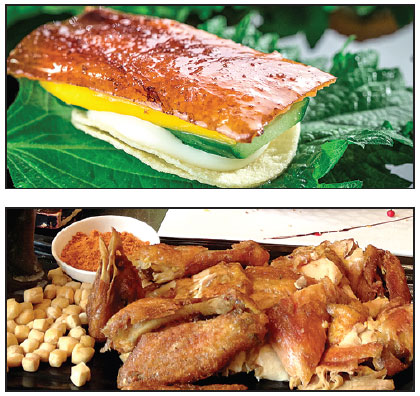Xi'an elevates mealtime to fine art
Updated: 2015-02-12 07:50
By Mike Peters(China Daily)
|
|||||||||||
It's easy to think of Xi'an cuisine as simply great noodles and street food. But visit the historic city and you're instantly reminded that Chang'an - as the city was known in its heyday - was the capital of the Tang Dynasty (AD 618-907) and the start of the old Silk Road.
It was the biggest city in the world at a time when ancient Chinese culture was at its peak, and the imperial court celebrated that at the table.
That culinary spirit finds expression in the deft hands of Waylon Fu, Chinese executive chef at Dragon Palace, in the Kempinski hotel in Xi'an.
While Dragon Palace is the hotel chain's brand for Chinese restaurants across China, Fu makes the menu here distinctly local, starting with Chang'an-style deep-fried chicken.
Tradition says this dish grew out of a cooking competition arranged by a Tang emperor, Fu says.
The winning version was first steamed in a bamboo basket, then flash-fried - a combination that delivered crispy skin outside and juicy, tender meat within.
Fu's rendition has the succulence and grand presentation one expects at an imperial banquet - served with garden greens, dried and grated red chilies, and a sweep of fried-dough pebbles that were (and still are) given to children on the second day of the second lunar month.
The crunchy snack is a talisman for prosperity and a big harvest in the coming year in China's wheat country.
Tang Dynasty poetry is as famed as its horses and its tricolored ceramics, and many dishes from that era beg to be expressed in verse.
One of those is lao wa-sa - which originated as a desperate meal in wartime.
The emperor, as the story goes, was impressed by the way his favorite general - in retreat at the time - made do by collecting water and foraged wild plants, and having it cooked in soldier's helmets.
Imperial chefs were instructed to concoct an upscale version of the dish in commemoration of that battlefield savvy.
The legacy is a rich, colorful stew with minced Chinese pancakes with soft-shell turtles (a delicacy the famous general would hardly have had at his disposal).
I was a little nonplussed by the bony bits of turtle - handled so deftly by my Chinese friends at the table - but I loved the meaty richness that it gave the broth.
Fu's team has the same elegant touch with beverages. A local favorite, hot pumpkin juice, is a veggie puree taken to ecstasy with fresh cream and a sweetener. The same technique was also employed with purple sweet potatoes.
The modestly named "dry-fried beef" must have thrilled the imperial court as well.
It was prettily served in a cornucopia with a mass of dried red chillies that gave the meat some spicy oomph without making it Sichuan-level incendiary.
My chopsticks kept sneaking back into those crispy beef nuggets even as other dishes arrived at the table.
A grilled lamb chop, fragrant with cumin and other spices, was a fine salute to the meat and herb traditions of the region.
But the showstopper of our meal may have shown the geographic reach of the land and maritime silk routes of their day: salad mango with duck.
In this surprising treat, strips of succulent roast fowl with crispy skin were layered with fresh cucumber, slices of mango from Thailand and slightly sweet cream.
The next day, there was another gem to find on the menu with roots in the Silk Road: baby cabbage beautifully poached in a thick saffron sauce that would have made Persian traders sing.
michaelpeters@chinadaily.com.cn


(China Daily 02/12/2015 page24)
Today's Top News
Russia's YotaPhone places big bet on China
EU leaders to urge stricter border checks in counter-terror drive
Leaders hold Ukraine peace talks as fighting surges
Costa Concordia captain sentenced to 16 years for 2012 shipwreck
Chinese investors shifting focus in global realty purchases
Greek PM easily wins confidence vote
Contact group on Ukraine reaches ceasefire deal
China should be alert to deflation risks
Hot Topics
Lunar probe , China growth forecasts, Emission rules get tougher, China seen through 'colored lens', International board,
Editor's Picks

|

|

|

|

|

|





